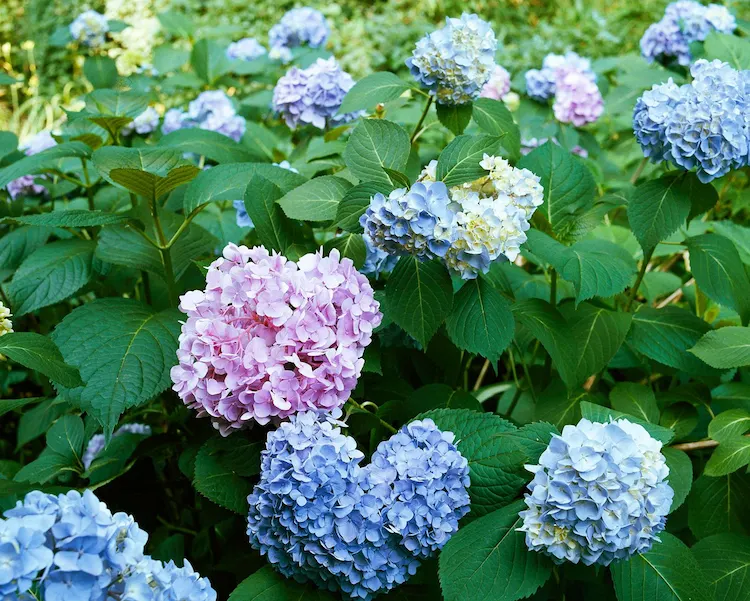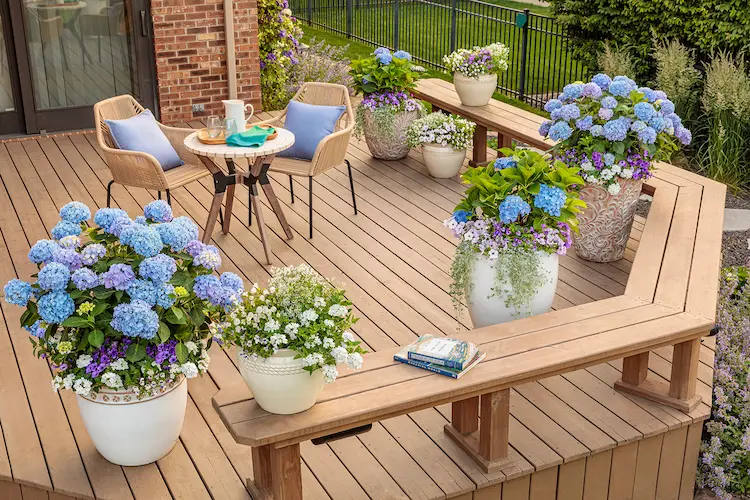Hydrangeas are very popular flowering shrubs that add a touch of elegance and bloom to a garden. Gardeners must consider that hydrangeas are demanding of the soil in which they grow. In this article you can read which soil is suitable for hydrangeas and how you can get the plants to grow healthily!
What should be considered when growing hydrangeas?
Hydrangeas can grow in both acidic and alkaline soils. If the soil pH is 6.5 or below (acidic), the flowers of large-leaved hydrangeas will be blue in color. If the pH of the soil is above 6.5 (i.e. either slightly acidic, pH neutral or alkaline), then the flowers will be pink. You can incorporate lime into the soil, which will raise the soil pH from acidic to less acidic, neutral pH, or alkaline.
What is the ideal soil structure for the plants?
Hydrangeas love moist growing conditions, so the soil structure should be able to retain moisture. Good drainage is also of great importance so that the roots do not suffer from root rot.
A high percentage of organic matter in the soil is perfect for hydrangeas. Organic matter has the property of retaining moisture and creating a porous structure for the roots, which favors good growth.
Earthworms are very useful for the good development of shrubs. They produce worm droppings, a concentrated form of nutrients that are very easily absorbed by plants. Earthworms dig channels through the soil that make room for roots to grow. This also loosens the soil and improves drainage, which favors the plants.
Soil nutrients useful for hydrangeas

What can you do to give your hydrangea enough nutrients? As already mentioned, organic matter is urgently needed for the plant to develop well. An annual layer of mulch around your hydrangeas is also a great way to continually enrich the soil with nutrients and stimulate the soil ecosystem.
Your shrubs will benefit from fertilizer if the soil is naturally poor or if the hydrangea’s roots are competing for nutrients with other plants and trees (e.g. pines). Hydrangeas do well with a general shrub fertilizer, but there are also fertilizers specific to hydrangeas. Special granulated hydrangea fertilizers contain extra magnesium and iron to promote flowering and meet nitrogen, phosphorus and potassium needs.
What soil for hydrangeas

There are some soil conditions for the plants to be aware of. Here we explain which soil favors the growth of the popular shrubs and which soils are not suitable.
Are sandy soils suitable for the shrubs
Sandy soil is not suitable for growing hydrangeas because the water seeps through the soil too quickly and dries out before the hydrangea’s roots can absorb moisture, causing the hydrangea to die off. Sandy soils are also poor in nutrients, and these plants need plenty of nutrients to thrive lushly.
If you grow your hydrangeas in sandy soil, you need to enrich the soil with plenty of organic matter. What Nutrients Should You Add? A mixture of compost and manure is ideal as both materials retain moisture well and manure in particular gives the soil a fertility boost.
Add as much organic matter as possible, even if it means replacing a large part of the sandy soil. You need to dig up the added compost at least 6 inches deep for the hydrangea roots to benefit. You can also add leaf moss or manure. This also helps with water retention and provides sufficient nutrients for the popular hydrangeas.
Which soil for hydrangeas: is clay soil suitable?

If you have a clay soil in your garden that is about 20% clay and the rest is 40% sand and 20% silt, then this soil is perfect for growing hydrangeas. The function of the loam is to conserve moisture, while the silt and sand provide good drainage and a porous texture enough for roots to grow easily into the soil. However, if you have a heavy clay soil, this can be problematic for the plants because the water drains slowly and this causes root rot.
What can you do if you have heavy clay soil in the garden? Just amend the soil before planting hydrangeas. Add plenty of organic matter like compost or manure. This will improve drainage and soil texture.
How to proceed: Remove the clay to a depth of about 25 cm and add some sand to the compost mixture. This way you prevent water from accumulating under the plant.
Clay soil usually has good fertility, so you do not need additional plant fertilizer. Another good thing about clay soil is that it retains water. If you plant your plants in clay soil, you may only need to water them twice a week during the growing season.
Soil for hydrangeas in pots

In general, an all-purpose clay mix is best for potted hydrangeas. However, remember that if you are growing a blue strain, you will need to maintain acidity levels over time. You should also refresh the mulch layer around your potted hydrangea every spring. Additional feeding is usually not required. Consider not giving the hydrangea too much nitrogen as this can encourage leaf growth and flowering may not be as profuse.